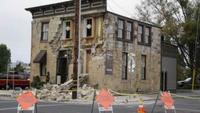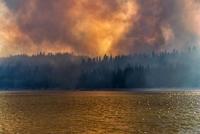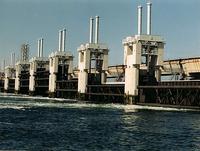-
SF posting seismic warning posters on vulnerable buildings in a retrofitting drive

In an effort to get property owners to retrofit vulnerable buildings, San Francisco is posting large signs — in English, Spanish, and Chinese, with red letters, and a drawing of a collapsed building — on apartment and hotel complexes that have failed to comply with the city’s seismic safety laws.The San Francisco tactic is similar to what city officials in Berkeley implemented in 2005, when building authorities placed small warning signs on at-risk wooden apartment buildings.
-
-
Simulating the ground motion of the south Napa earthquake
Lawrence Livermore National Laboratory (LLNL) seismologists are tapping into LLNL’s supercomputers to simulate the detailed ground motion of last month’s magnitude 6.0 south Napa earthquake. The Napa tremor is the largest to hit the Bay Area since the magnitude 6.9 Loma Prieta event in 1989. Seismic simulations allow scientists better to understand the distribution of shaking and damage that can accompany earthquakes, including possible future “scenario” earthquakes.
-
-
A Santa Ana Wildfire Threat Index developed

UCLA atmospheric scientists were instrumental in the creation of the Santa Ana Wildfire Threat Index — a new tool to classify the fire threat potential of the powerful, hot, dry Santa Ana wind, which can turn a spark into an inferno. The index was introduced 17 September by the U.S. Forest Service, in collaboration with UCLA and San Diego Gas and Electric.
-
-
Silicon Valley tech startups developing earthquake early warning mobile apps
Silicon Valley tech startups are developing mobile applications to alert residents about earthquakes, but most lack a direct source to the seismic sensors deployed by the state’s ShakeAlertsystem which sends alerts seconds before the ground begins to shake.Googleis currently the only tech company with an agreement to access ShakeAlert’s data feed, and analysts anticipate that Google will integrate ShakeAlert’s system with its Nestthermostat, a Web-connected thermostat that sends alerts to users’ phone and e-mail with details on home temperature and energy use.
-
-
Tornadoes occurring earlier in Tornado Alley
About 1,300 tornadoes hit the United States every year, killing an average of sixty people. Peak tornado activity in the central and southern Great Plains of the United States is occurring up to two weeks earlier than it did half a century ago, according to a new study whose findings could help states in “Tornado Alley” better prepare for these violent storms.
-
-
Cities seek new ways to cope with sea level rise – and look to the Dutch for advice

Scientists predict a “tenfold increase” in the frequency of hurricanes and other storms, as well as sea-level rise of eleven to twenty-four inches within a little more than three decades – and planners and managers in U.S. coastal cities are looking at new ways to prepare their cities’ infrastructure for these challenges. In New York and New Orleans, city planners are studying the experience of the Dutch, who have gained a lot of experience – and fame — for their water control methods.
-
-
The State of New York launches disaster preparedness initiatives
The state of New York is implementing a proactive strategy to deal with the threat of terrorism and natural disasters like Superstorm Sandy. Local municipalities have been granted state support for emergency preparedness projects, and the state’s Division of Homeland Security and Emergency Services(DHSES), led by commissioner Jerome Hauer, has expanded its regional footprint from five planning/response regions to ten. “Mother Nature has become much more aggressive, so we too must adopt a similar posture to ensure we are ready to respond effectively when the next disaster strikes, Hauer says.
-
-
Rural towns lose to urban centers in competition for coastal protection funding
Infrastructure protection planners say there are only three ways coastal communities can defend themselves against rising sea levels: defend the shoreline with both natural and man-made barriers; raise key infrastructure such as buildings and roads; or retreat from the shoreline. Each of these options costs a fortune to follow. Smaller, more rural coastal communities in many states are finding that they are having a hard time competing with more powerful interests in coastal urban cities over funding for protection against sea-level rise.
-
-
Not all Oakland buildings are equally seismically vulnerable
A mobile app which allows Oakland resident to check on whether their buildings are seismically vulnerable reveals that there is a vast inequality between safe and vulnerable homes in the city, as residents living in less-affluent, older multi-unit buildings would suffer the most in a major quake. Oakland is home to hundreds of those vulnerable buildings that may collapse in a major earthquake, and there is no law mandating property owners to retrofit buildings to safer standards.
-
-
Colorado recovering as it marks one year anniversary of devastating flood
On 29 September 2013 Colorado experienced the most severe natural disaster that had ever befallen the state. Within three days much of the state had experienced a rainfall equivalent to its total for the entire year. In the end, nine people died, nearly 1,000 were evacuated by helicopter, and 1,800 homes were destroyed. The total cost of the damage reached $2.9 billion. Now, a year later, Colorado is finally coming back.
-
-
Sea level rise affecting the infrastructure, psychology of key mid-Atlantic towns
Scientific research and flooding trends have led many to speculate that the Atlantic coast of the United States is already sinking. Mid-Atlantic towns on the coast stretching from Virginia to South Carolina have been experiencing increased flooding and receiving reports and satellite findings from government agencies, leading many of those living on the mid-Atlantic coast to wonder whether their hometowns are doomed.
-
-
Inexpensive, home-made quake early-warning system can be a life saver

UC Berkeley astrophysics professor Josh Bloom has developed an earthquake early-warning (EEW) device meant for the home or office. Resembling a home fire alarm or carbon monoxide sensor, the device was built using a Raspberry Pi single-board computer, an SD card, wired power speaker, and mini Wi-Fi adapter — costing roughly $110 in parts.
-
-
Start-ups offer apps which help people cope with disasters
Open data policies which allow government agencies to share public information with citizens and the private sector have made California welcoming to startups dedicated to helping communities recover following a disaster.For example: Appallicious offers an app which allows subscribed cities and towns to select from hundreds of data sets, then share with the public, information on evacuation routes, current hazards, and location of critical resources.BlueLine Grid allows public employees from different agencies to communicate with each other during a crisis.SeeClickFix is connecting residents to their local government.
-
-
Florida Keys preparing for rising sea levels
The Florida Keys rank third among East Coast communities at risk of “population displacement” due to higher seas which will flood nearby land. Scientists say that if sea levels continue to rise at the current rate, high waters which drowned the Keys during 2005’s Hurricane Wilma could become a normal part of living in Monroe County by 2060. Officials in Monroe County, Florida are putting together a GreenKeys Sustainability Action Plan which will help residents of the Florida Keys maintain a sustainable lifestyle while under threat of sea-level rise due to climate change.
-
-
No Fukushima radiation found in California’s coastal areas
Following the 11 March 2011 Fukushima disaster, researches wanted to see whether radioactivity could be found in Bay Area precipitation. They collected weeks’ worth of rainwater around UC Berkeley Campus to find out. The results: low levels of a number of different radioactive nuclei produced by the fission of uranium-235 including, cesium-134, cesium-137, and iodine-131. “The levels we saw were detectable, but low and not a health hazard to anyone,” said UC Berkeley’s nuclear engineering professor Eric Norman.
-
- All
- Regional
- Water
- Biometrics
- Borders/Immig
- Business
- Cybersecurity
- Detection
- Disasters
- Government
- Infrastructure
- International
- Public health
- Public Safety
- Communication interoperabillity
- Emergency services
- Emergency medical services
- Fire
- First response
- IEDs
- Law Enforcement
- Law Enforcement Technology
- Military technology
- Nonlethal weapons
- Nuclear weapons
- Personal protection equipment
- Police
- Notification /alert systems
- Situational awareness
- Weapons systems
- Sci-Tech
- Sector Reports
- Surveillance
- Transportation
Advertising & Marketing: advertise@newswirepubs.com
Editorial: editor@newswirepubs.com
General: info@newswirepubs.com
2010-2011 © News Wire Publications, LLC News Wire Publications, LLC
220 Old Country Road | Suite 200 | Mineola | New York | 11501
Permissions and Policies
Editorial: editor@newswirepubs.com
General: info@newswirepubs.com
2010-2011 © News Wire Publications, LLC News Wire Publications, LLC
220 Old Country Road | Suite 200 | Mineola | New York | 11501
Permissions and Policies
